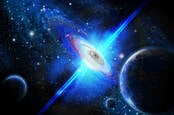This article is more than 1 year old
Planets may lurk in harshest environments. Not that Novell NetWare server you can't unplug – black holes
Technically possible but there's no way to check... for now
Giant planets up to ten times the mass of the Earth can form around violent supermassive black holes without the need for stars, according to research accepted into The Astrophysical Journal.
"With the right conditions, planets could be formed even in harsh environments, such as around a black hole," Keiichi Wada, first author of the study and a professor at Kagoshima University, Japan, declared on Monday.
Greedy supermassive black holes actively feeding on material at the center of galaxies aren’t particularly known for creating nurturing environments for planets to be born. As they pull in surrounding matter into a swirling accretion disk, they also blast the area with strong jets of radiation.
Despite their destructive nature, black hole accretion disks carry vital ingredients for planets to form. Dust particles can compress under gravitational forces to form small bits of debris that glom together to create planetesimals, and eventually planets. The same process has been observed in protoplanetary disks around young stars.
The accretion disks surrounding supermassive black holes are larger and heftier, too, containing enough material worth a hundred thousand times the mass of our Sun. Planets can only form here, however, if parts of the disk is shielded from the hostile radiation. The researchers reckon that some disks are so dense that some parts further out from the center can block incoming electromagnetic energy.
"Our calculations show that tens of thousands of planets with ten times the mass of the Earth could be formed around ten light-years from a black hole," said Eiichiro Kokubo, co-author of the paper and a professor at the National Astronomical Observatory of Japan. The process is much slower than in traditional protoplanetary disks, however, and could take up to several hundred million years instead of just tens of millions of years.
“Around black holes there might exist planetary systems of astonishing scale," Kokubo added.
The mathematical simulations described in the paper might be theoretically sound, but unfortunately there is no way to prove it at the moment. There are currently no known methods of observing a black hole’s accretion disk at a high enough resolution to even spot baby planets forming, so the research remains more a curiosity than anything else.
The paper has been accepted for publication in The Astrophysical Journal; here's a free pre-print copy on arXiv. ®

